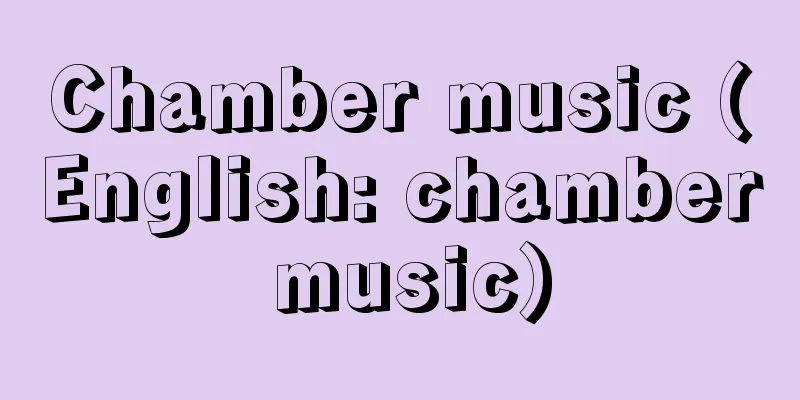Chamber music (English: chamber music)

|
In Western instrumental ensembles, the arrangement of instruments in which each part is assigned a soloist is called an ensemble, and instrumental ensembles composed of ensembles are collectively called chamber music. They are classified into duets to nonets depending on the number of instruments, and various forms are possible depending on the types and combinations of instruments used, but historically there have been about a dozen standard forms. The most important standard form is the string quartet, consisting of two violins, a viola, and a cello. Other forms also feature strings, and often include more or less instruments than the string quartet (string trio, string quintet), or an additional instrument. In the latter case, a piano and string combination is called a piano trio, piano quartet, or piano quintet, and a wind and string combination is called a flute quartet or clarinet quintet. A violin and piano duet is simply called a violin sonata. A wind-only form is a woodwind quintet with flute, oboe, clarinet, horn, and bassoon. For sextets and above, there is no set form, and any combination of instruments can be used. From a formal standpoint, the strict four-movement sonata form prevails throughout the various forms, and chamber music can be called a sonata for an ensemble. [Hajime Okubo] historyChamber music only acquired these characteristics after the Classical period, but small-scale ensembles were widely practiced from the late Middle Ages when secular music emerged, and by the Baroque period it had grown into a major field of music. However, the term chamber music itself had a slightly different meaning than it had since the Classical period. The original term for chamber music, musica da camera, began to be used in Italy in the mid-16th century to mean secular music as opposed to church music. Camera means a room in the court of a nobleman. In the Baroque period, when cameras became the main stage for musical development along with churches and theaters, all music played there came to be called chamber music. Thus, the concept of chamber music at that time was literally defined by the place where music was played, which was a room, and was broad, including solo instruments, vocal music, and even orchestral music. The concept of chamber music began to be understood from the perspective of organization at the end of the 18th century, when the center of musical life shifted from the noble cameras to public concerts for citizens. A representative form of chamber music in the narrow sense of the word during the Baroque period is the trio sonata, consisting of two violins and basso continuo. In the classical period, the trio sonata fell into disuse with the disappearance of basso continuo, and a new chamber music was formed based on entertainment music such as serenades and divertimento. In the early days, the distinction between the sonata and the orchestra was unclear, but in parallel with the development of the symphony as a sonata for orchestra, the characteristic of modern chamber music, the sonata for ensemble, was established. The greatest role was played by Haydn, who composed over 70 string quartets, and his dialogue-like writing style based on an equal relationship between each instrument was considered ideal in other forms as well. Mozart learned from Haydn and tried various forms including piano and wind instruments, and Beethoven's works represent the pinnacle of chamber music, past and present, in their rigorous structure and deep spiritual expression. During the Romantic period, which sought to expand the means of expression, chamber music, which was limited in tone and volume, lost its former importance, and many composers did not tackle this genre at all. However, composers of the Classical tradition, such as Schubert, Mendelssohn, Schumann, Brahms, Dvorak, and Franck, wrote works that harmoniously combined classical structure with romantic emotion. In the 20th century, chamber music regained its importance under the trend of neoclassicism, and many composers, including Schoenberg, Bartók, and Stravinsky, wrote works for it. A new characteristic of chamber music was the exploration of free expression that departed from traditional forms and styles. [Hajime Okubo] [Reference] |Source: Shogakukan Encyclopedia Nipponica About Encyclopedia Nipponica Information | Legend |
|
西洋の器楽合奏において、各パートに1人の独奏者を配する楽器編成法をとくに重奏(アンサンブル)といい、重奏による器楽合奏曲を総称して室内楽という。楽器の数により二重奏から九重奏に区分され、用いる楽器の種類や組合せによってさまざまな形態が可能だが、歴史的に形成された定型は十数種ほどである。もっとも重要な定型は、二つのバイオリンにビオラとチェロからなる弦楽四重奏である。 他の定型の場合にも弦楽器が主体となっており、弦楽四重奏の楽器数を増減したり(弦楽三重奏、弦楽五重奏)、それに別種の楽器を一つ加えたものが多い。後者の場合、ピアノと弦楽器の組合せはピアノ三重奏、ピアノ四重奏、ピアノ五重奏、管楽器と弦楽器の組合せはフルート四重奏、クラリネット五重奏などとよばれる。また、バイオリンとピアノの二重奏は単にバイオリン・ソナタとよばれる。管楽器のみによる定型にはフルート、オーボエ、クラリネット、ホルン、ファゴットによる木管五重奏がある。六重奏以上になると定型といったものはなく、任意の楽器の組合せがなされる。形式的にみると、さまざまな形態を通じて厳格な4楽章ソナタの形式が主流をなしており、室内楽を重奏のためのソナタということができる。 [大久保一] 歴史室内楽がこうした特徴を備えるのは古典派以後のことであるが、少数楽器の合奏は世俗音楽の台頭した中世末期以来広く行われ、バロック時代には音楽の主要な一分野にまで成長していた。ただし、室内楽ということば自体は古典派以降とはやや異なる意味をもっていた。室内楽の原語「ムジカ・ダ・カメラ」は、16世紀中ごろのイタリアで教会音楽に対する世俗音楽の意味で用いられ始めた。カメラとは王侯貴族の宮廷内の部屋を意味する。バロック時代に入り、教会・劇場と並んでカメラが音楽発展の主要な舞台になると、そこでの音楽全般が室内楽とよばれるようになった。このように当時の室内楽の概念は、文字どおり室内という奏楽の場によって規定されており、独奏や声楽、さらに管弦楽をも含む幅広いものであった。室内楽の概念が編成面からとらえられるようになったのは、音楽生活の中心が貴族のカメラから市民的な公開演奏会に移った18世紀末のことである。バロック時代における狭義の室内楽の代表的形態としては、二つのバイオリンと通奏低音からなるトリオ・ソナタがあげられる。 古典派時代に入ると、通奏低音の消滅に伴いトリオ・ソナタは廃れ、セレナードやディベルティメントなどの娯楽音楽を出発点に新しい室内楽が形成された。初期には管弦楽との編成上の区別はあいまいであったが、交響曲が管弦楽のためのソナタとして発展するのと並行して、重奏のためのソナタという近代室内楽の特質が確立された。もっとも大きな役割を果たしたのは70余の弦楽四重奏を作曲したハイドンで、各楽器の対等な関係に基づく対話風の書法は他の形態においても理想とされた。モーツァルトはハイドンに学ぶとともにピアノや管楽器を含む多彩な形態を試み、ベートーベンの作品は構成の厳格さと深い精神性の表現において古今の室内楽の頂点を形づくっている。表現手段の拡大を求めたロマン派時代には、音色・音量の限られた室内楽は以前ほどの重要性を失い、この分野をまったく手がけない作曲家も多かったが、シューベルト、メンデルスゾーン、シューマン、ブラームス、ドボルザーク、フランクなど古典派の流れをくむ作曲家により、古典的構成とロマン的情感の調和した作品が書かれた。 20世紀に入ると、新古典主義の潮流のもとで室内楽はふたたび重要性を増し、シェーンベルク、バルトーク、ストラビンスキーら多くの作曲家が作品を書いている。新たな特徴としては、伝統的な形態や形式を離れた自由な室内楽的表現の探究があげられる。 [大久保一] [参照項目] |出典 小学館 日本大百科全書(ニッポニカ)日本大百科全書(ニッポニカ)について 情報 | 凡例 |
>>: Hygrometer - Humidity meter
Recommend
Kanze Saburo (Motokiyo)
...He was commonly known as Saburo, and his real ...
automatism
...Although it did not come to the surface during...
Euphrosyne - Euphrosyne
…In Latin, they are called Gratiae, and in Englis...
Hanahikokin - Kagenkin
…Western music education was being carried out in...
Koden
〘Noun〙① Under the ritsuryo system, fields owned by...
Operating revenue
Revenues generated from a company's main busin...
Johns Hopkins University - Johns Hopkins University
A private university with its headquarters in Balt...
Taiwan Daily News - Taiwan Daily News
This was a representative colonial newspaper publi...
Emperor Taiwu
He was the third emperor of the Northern Wei Dyna...
Volunteer - Shiganhei
This refers to soldiers who are not permanent memb...
Bahama Islands (English spelling)
An archipelago in the northwestern part of the Wes...
hMG - HMG
…It is effective for mild ovulation disorders suc...
Amabe - Fishermen's Club
One of the Shinabe in the pre-Taika period. Also ...
Tokorozawa [city] - Tokorozawa
Sayama City is located in the southern part of Sai...
Karasawayama
A mountain located in Sano City, southwest of Toch...









